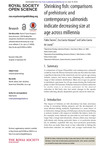Search
Now showing items 1-5 of 5
Mitigating the Goldilocks effect
(2014)
In ichnology, the Goldilocks effect describes a scenario in which a substrate must be ‘just right’ in order for tracks to form—too soft, the animal will be unable to traverse the area, and too firm, the substrate will not ...
Shrinking fish: comparisons of prehistoric and contemporary salmonids indicate decreasing size at age across millennia
(The Royal Society, 2014)
A comparison of Upper Palaeolithic and contemporary salmonid vertebrae from the Iberian Peninsula indicates that there has been a significant decrease in the mean body size for a given age among Atlantic salmon and brown ...
Tooth serration morphologies in the genus Machimosaurus from the Late Jurassic of Europe
(2014)
Machimosauruswas a large-bodied durophagous/chelonivorous genus of teleosaurid crocodylomorph that lived in shallow marine and brackish ecosystems during the Late Jurassic. Among teleosaurids, Machimosaurusand its sister ...
Revision of the Late Jurassic teleosaurid genus Machimosaurus
(2014)
Machimosaurus was a large-bodied genus of teleosaurid crocodylomorph, considered to have been durophagous/ chelonivorous, and which frequented coastal marine/estuarine ecosystems during the Late Jurassic. Here, we revise ...
Egg shape changes at the theropod bird transition, and amorphometric study of amniote eggs
(2014)
The eggs of amniotes exhibit a remarkable variety of shapes, from spherical to elongate and from symmetrical to asymmetrical. We examine eggshell geometry in a diverse sample of fossil and living amniotes using geometric ...





